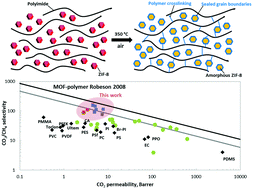当前位置:
X-MOL 学术
›
Energy Environ. Sci.
›
论文详情
Our official English website, www.x-mol.net, welcomes your
feedback! (Note: you will need to create a separate account there.)
Highly selective gas separation membrane using in situ amorphised metal–organic frameworks
Energy & Environmental Science ( IF 32.4 ) Pub Date : 2017-08-09 00:00:00 , DOI: 10.1039/c7ee01872j Aylin Kertik 1, 2, 3, 4 , Lik H. Wee 1, 2, 3, 4 , Martin Pfannmöller 4, 5, 6, 7 , Sara Bals 4, 5, 6, 7 , Johan A. Martens 1, 2, 3, 4 , Ivo F. J. Vankelecom 1, 2, 3, 4
Energy & Environmental Science ( IF 32.4 ) Pub Date : 2017-08-09 00:00:00 , DOI: 10.1039/c7ee01872j Aylin Kertik 1, 2, 3, 4 , Lik H. Wee 1, 2, 3, 4 , Martin Pfannmöller 4, 5, 6, 7 , Sara Bals 4, 5, 6, 7 , Johan A. Martens 1, 2, 3, 4 , Ivo F. J. Vankelecom 1, 2, 3, 4
Affiliation

|
Conventional carbon dioxide (CO2) separation in the petrochemical industry via cryogenic distillation is energy intensive and environmentally unfriendly. Alternatively, polymer membrane-based separations are of significant interest owing to low production cost, low-energy consumption and ease of upscaling. However, the implementation of commercial polymeric membranes is limited by their permeability and selectivity trade-off and the insufficient thermal and chemical stability. Herein, a novel type of amorphous mixed matrix membrane (MMM) able to separate CO2/CH4 mixtures with the highest selectivities ever reported for MOF based MMMs is presented. The MMM consists of an amorphised metal–organic framework (MOF) dispersed in an oxidatively cross-linked matrix achieved by fine tuning of the thermal treatment temperature in air up to 350 °C which drastically boosts the separation properties of the MMM. Thanks to the protection of the surrounding polymer, full oxidation of this MOF (i.e. ZIF-8) is prevented, and amorphisation of the MOF is realized instead, thus in situ creating a molecular sieve network. In addition, the treatment also improves the filler-polymer adhesion and induces an oxidative cross-linking of the polyimide matrix, resulting in MMMs with increased stability or plasticization resistance at high pressure up to 40 bar, marking a new milestone as new molecular sieve MOF MMMs for challenging natural gas purification applications. A new field for the use of amorphised MOFs and a variety of separation opportunities for such MMMs are thus opened.
中文翻译:

使用原位非晶金属-有机骨架的高选择性气体分离膜
在石油化学工业中,通过低温蒸馏进行常规的二氧化碳(CO 2)分离需要消耗大量能源并且对环境不利。备选地,由于低的生产成本,低的能量消耗和易于规模化,基于聚合物膜的分离引起了人们的极大兴趣。然而,商业聚合物膜的实施受到其渗透性和选择性的折衷以及热和化学稳定性不足的限制。本文中,一种新型的能够分离CO 2 / CH 4的非晶态混合基质膜(MMM)介绍了基于MOF的MMM具有最高选择性的混合物。MMM由分散在氧化交联基质中的无定形金属-有机骨架(MOF)组成,通过微调高达350°C的空气中的热处理温度,可以大大提高MMM的分离性能。通过保护周围的聚合物,可以防止该MOF(即ZIF-8)完全氧化,从而可以原位实现MOF的非晶化创建分子筛网络。此外,该处理还改善了填料与聚合物的粘合性,并诱导了聚酰亚胺基体的氧化交联,从而使MMM在高达40 bar的高压下具有更高的稳定性或抗塑化性,标志着新的里程碑成为了新的分子筛MOF适用于具有挑战性的天然气净化应用的MMM。因此,打开了使用非晶态MOF的新领域以及此类MMM的各种分离机会。
更新日期:2017-11-08
中文翻译:

使用原位非晶金属-有机骨架的高选择性气体分离膜
在石油化学工业中,通过低温蒸馏进行常规的二氧化碳(CO 2)分离需要消耗大量能源并且对环境不利。备选地,由于低的生产成本,低的能量消耗和易于规模化,基于聚合物膜的分离引起了人们的极大兴趣。然而,商业聚合物膜的实施受到其渗透性和选择性的折衷以及热和化学稳定性不足的限制。本文中,一种新型的能够分离CO 2 / CH 4的非晶态混合基质膜(MMM)介绍了基于MOF的MMM具有最高选择性的混合物。MMM由分散在氧化交联基质中的无定形金属-有机骨架(MOF)组成,通过微调高达350°C的空气中的热处理温度,可以大大提高MMM的分离性能。通过保护周围的聚合物,可以防止该MOF(即ZIF-8)完全氧化,从而可以原位实现MOF的非晶化创建分子筛网络。此外,该处理还改善了填料与聚合物的粘合性,并诱导了聚酰亚胺基体的氧化交联,从而使MMM在高达40 bar的高压下具有更高的稳定性或抗塑化性,标志着新的里程碑成为了新的分子筛MOF适用于具有挑战性的天然气净化应用的MMM。因此,打开了使用非晶态MOF的新领域以及此类MMM的各种分离机会。











































 京公网安备 11010802027423号
京公网安备 11010802027423号